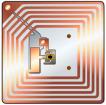WHAT ARE RFID TAGS?

AN RFID TAG
Radio Frequency Identification (RFID) tags are data carrying devices suitable for attachment to other objects. The Data stored in these tags are used to store basic information about the object to which it is attached. RFID tags are silicon-based transponders, which replaces the lines in the popular barcodes with a low cost processing unit and a radio link.
Amazon Ads Buy; check and compare prices and read reviews of Electronic gadgets |
The data or information on the tag is downloaded into it during manufacture or with special devices for writing on the memory. The information on the tag is read via its radio link using a special device called an RFID reader. Information about an object is written on the device, after which it is attached to the object. This information stored in the tag can be easily read by bringing the object within the range of the RFID reader.

RFID readers
RFID tags operate at three frequency ranges these are low frequency (125 KHz or 134 KHz), high frequency (13.56MHz), and the ultra-high-frequency (UHF) tags (300MHz to 1GHz). So far, most RFID applications have used low frequency or high-frequency tags. According to suppliers, Philips and Texas instrument, in 2004 high frequency tags were ordered the most.
RFID have grown in popularity over the years because of their applications in inventory management and tracking of objects (asset management). It allows rapid inventory of bulk items, thereby making it very vital in distribution centers and supermarkets.
However, numerous applications for this device have emerged over the years. These devices can now be implanted inside the human tissue, like under the skin of the arm; this can be used as identification at work or in a nightclub. It can also be used for authenticating payment, and much more.
RFID tags implanted under the skin can also be used to store medical records, which can help medical personnel in identifying the patient and in having a proper knowledge of his medical records or history. Access to such information can enable doctors administer medication even when the patient is unconscious.
Many organizations use these devices because it helps in the tracking of supply and distribution chain. European aircraft manufacturer, airbus uses these tags on replaceable parts like brakes, seats, and lifebelts of the plane it builds. Retail giants such as Wal-mart in the United States and Tesco in the United Kingdom are already using this asset identification and tracking device. These investments help these companies efficiently manage their supply and distribution chains.

A passive RFID tag
In 2004, the United States military mandated all its suppliers to start using passive RFID tags on packages by January 2005. This was to ensure that meals and vital supplies could be constantly tracked and assets efficiently managed.
RFID tags are expected to become ubiquitous as prices fall. In addition, the news of the organic radical battery (ORB), which will improve processing power, will help in making this tags mainstream.
However, RFID tag has its problems. One of this is the privacy concern. Consumer protection groups are claiming that these tags will lead to an invasion of privacy if used in supermarkets because it can be used in tracking individual’s buying habits. In addition a tag implanted under the skin can be read by anybody with an RFID reader, which will take identity theft to the next level.
Malicious hackers can use the tags to distribute viruses in a network. This was demonstrated in 2006 by a group of security researchers. Virus can infect a tag during manufacture. These devices can also be compromised by taking advantage of their limited processing ability. An infected tag when read can transfer the virus onto the RFID reader. Since most readers will be connected to a network, the virus can easily infect the network. This they say can cause many problems for companies in the future.
Despite these set backs RFID tags take up have been very high as the pros out weighs the cons.
0 Comments:
Post a Comment
<< Home